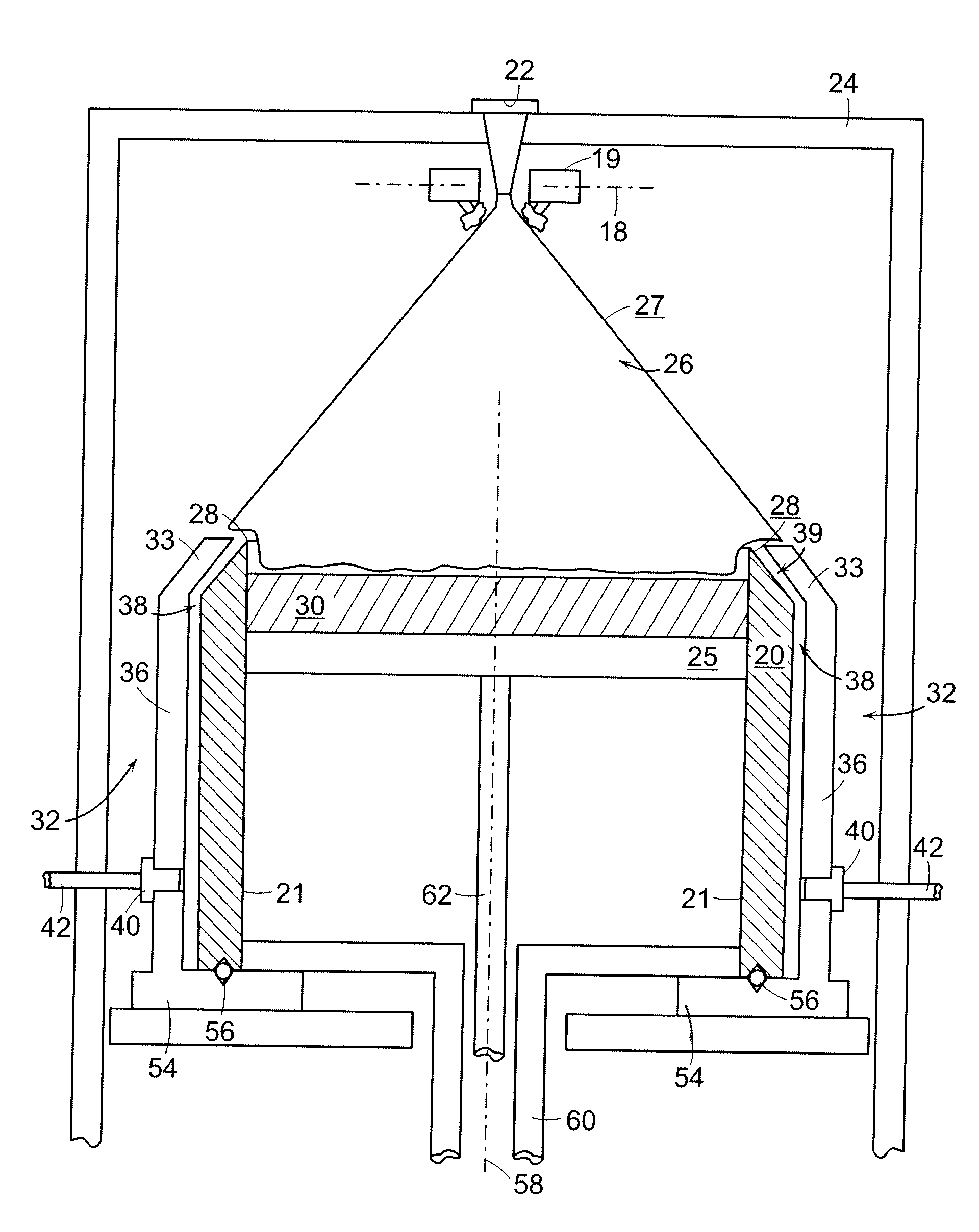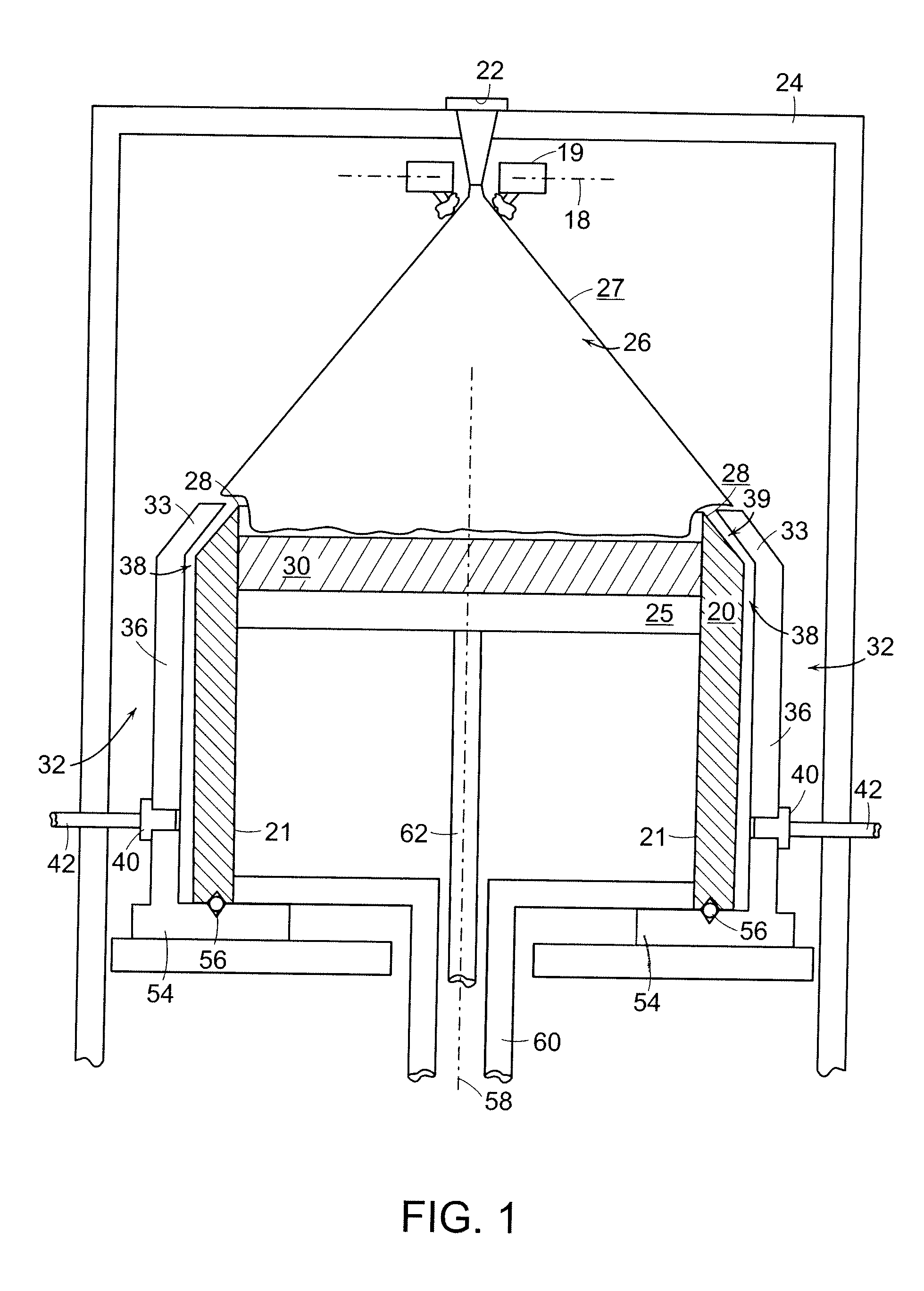Casting Apparatus and Method
a technology of casting apparatus and casting method, which is applied in the direction of coating, molten spray coating, metallic material coating process, etc., can solve the problems of affecting the formation of large diameter preforms, affecting the quality of metal alloy casting, and unavoidable byproducts of spray forming, so as to reduce the amount of spray droplets, prevent overspray accumulation, and prevent the effect of forming
- Summary
- Abstract
- Description
- Claims
- Application Information
AI Technical Summary
Benefits of technology
Problems solved by technology
Method used
Image
Examples
example 1
Evaluation of Gas Injector Gap Configuration
[0038]Referring to FIG. 9, various test samples, i.e., Test Samples A-D and F, were utilized to re-direct a droplet spray of molten metallic material as described above. The test samples were then examined to compare the ability of gas injectors having different configurations to reduce the adhesion or accumulation of overspray onto the test samples. Test Sample A, referring to FIGS. 9 and 10, included a coupon which was configured to simulate at least a portion of a mold side wall and a gas injector as outlined above. Test Sample A included a vertical surface (demarcated “A” in FIG. 10), a top surface, a gap positioned intermediate the vertical surface and the top surface, and a plenum configured to place a source of inert gas in fluid communication with the gap. As depicted in FIG. 9, the gap included an axis oriented at a 60 degree angle with respect to the horizontal, i.e., at a 30 degree angle with respect to an axis of the droplet sp...
example 2
Further Evaluation of Gas Injector Gap Configuration
[0042]Referring to FIG. 17, various additional test samples, i.e., Test Samples G, H, and J, were also utilized to re-direct a droplet spray of molten metallic material. Similar to the above, the test samples were then examined to compare the ability of the gas injectors to reduce the adhesion or accumulation of overspray onto the test samples. Test Sample G, H, and J, similar to Test Samples A-D and F, each included a coupon which was configured to simulate at least a portion of a mold side wall and a gas injector. As depicted in FIG. 17, the gas injector of Test Sample G included a gap having an axis oriented at an approximately 60 degree angle with respect to the horizontal, i.e., at an approximately 30 degree angle with respect to an axis of the droplet spray. As also depicted in FIG. 17, Test Sample H included a gap having an approximately 45 degree axis and Test Sample J included a gap having an approximately 67 degree axis.
[...
example 3
Evaluation of Inert Gas Pressure
[0045]Referring to FIG. 13, various specimens of Test Sample A were utilized to re-direct a droplet spray of molten metallic material as described above. The test samples were then examined to compare the ability of various gas injectors having substantially the same configuration, but supplied with inert gas flows having different pressures, to reduce the adhesion or accumulation of overspray onto the test samples. In the first example, depicted in FIG. 13(a), nitrogen gas having a pressure of approximately 0.2 bar was supplied to the test sample. In the second example, depicted in FIG. 13(b), nitrogen gas having a pressure of approximately 1.0-1.2 bar was supplied to the second test sample and, in the third example, depicted in FIG. 13(c), nitrogen gas having a pressure of approximately 2-3 bar was supplied to the third test sample. As illustrated in FIG. 13, it was observed that less overspray accumulated on the third test sample (2-3 bar) than on ...
PUM
| Property | Measurement | Unit |
|---|---|---|
| surface roughness | aaaaa | aaaaa |
| angle | aaaaa | aaaaa |
| angle | aaaaa | aaaaa |
Abstract
Description
Claims
Application Information
 Login to View More
Login to View More - R&D
- Intellectual Property
- Life Sciences
- Materials
- Tech Scout
- Unparalleled Data Quality
- Higher Quality Content
- 60% Fewer Hallucinations
Browse by: Latest US Patents, China's latest patents, Technical Efficacy Thesaurus, Application Domain, Technology Topic, Popular Technical Reports.
© 2025 PatSnap. All rights reserved.Legal|Privacy policy|Modern Slavery Act Transparency Statement|Sitemap|About US| Contact US: help@patsnap.com



